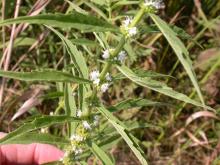Wildflowers, Grasses and Other Nonwoody Plants
Media

Species Types
Scientific Name
Asplenium rhizophyllum (syn. Camptosorus rhyzophyllus)
Description
One of Missouri’s most distinctive ferns, walking fern walks. Its long, triangular leaves take root at the elongated tips, forming new plantlets.
Media

Species Types
Scientific Name
Pellaea atropurpurea
Description
Purple cliff brake is a fern that grows from crevices in limestone and dolomite rocks, or in rocky soils near them. Its leathery, blue-gray leaflets, which are oval to lance-shaped, make the fronds seem not very fernlike.
Media

Species Types
Scientific Name
Pellaea glabella
Description
Smooth cliff brake is almost always seen growing out of an exposed limestone or dolomite bluff or rock. Its fronds, with blue-gray, lance-shaped, ovate, or oblong leaflets, are not very fernlike.
Media

Species Types
Scientific Name
Sagittaria spp.
Description
Arrowheads are aquatic plants with erect, usually arrow-shaped leaves and distinctive three-petaled flowers. They are often called duck potatoes because ducks, geese, and swans relish the tuberlike rootstocks.
Media

Species Types
Scientific Name
Chenopodium album
Description
Lamb’s quarters won’t win any beauty contests for its flowers, but it merits an award for being both a common garden weed as well as a nutritious leafy green valued around the world.
Media

Species Types
Scientific Name
Lycopus americanus
Description
Not the showiest of wildflowers, American bugleweed will catch your eye with its interesting geometry. The narrow, toothed leaves are opposite on the stalks and occur at right angles to the pair below.
Media

Species Types
Scientific Name
Xanthium strumarium
Description
Common cocklebur occurs statewide in open, disturbed, lowland habitats. It is a common weed in crop fields. It has wide, rough, coarsely toothed leaves; stout, often purple-speckled stems; and characteristic burs with hooked spines.
Media

Species Types
Scientific Name
Viola spp.
Description
Violets, as a group, are fairly easy to identify, with their colorful five-petaled “faces” so welcome in springtime. Missouri has 17 species, and some are confusingly similar. This page introduces them as a group.
Media

Species Types
Scientific Name
Packera spp. (formerly Senecio spp.)
Description
Ragworts, or groundsels, have several common names, and separating the different species can be a little tricky. But members of genus Packera, with their bright yellow daisy-like flowers, are distinctive as a group. Seven species have been recorded in Missouri.
Media

Species Types
Scientific Name
Packera plattensis (formerly Senecio plattensis)
Description
Prairie ragwort is one of seven Packera species in our state. It grows in sunny, open habitats. Look for its clusters of bright yellow, daisylike flowers in May and June.
See Also
About Wildflowers, Grasses and Other Nonwoody Plants in Missouri
A very simple way of thinking about the green world is to divide the vascular plants into two groups: woody and nonwoody (or herbaceous). But this is an artificial division; many plant families include some species that are woody and some that are not. The diversity of nonwoody vascular plants is staggering! Think of all the ferns, grasses, sedges, lilies, peas, sunflowers, nightshades, milkweeds, mustards, mints, and mallows — weeds and wildflowers — and many more!





















